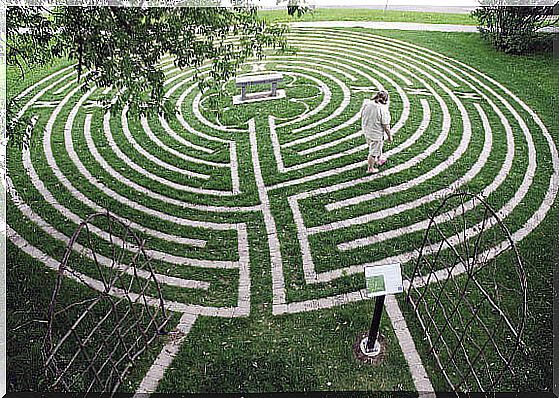Learning To Meditate While Walking

There are those who cannot learn to meditate. The mind does not tune in to the still calm that allows one to practice the full attention with which to reach a state of profound tranquility. However, something as simple as walking can make a difference: the pains go away and the mind clears almost immediately.
We have already told you about different therapeutic approaches, such as the Mindfulness technique, for example. Not all techniques are useful for everyone. Teenagers, as well as people with high anxiety or who have experienced some trauma, cannot reach this perfect relaxation point to learn to be more aware of their inner world.
When the mind screams, when thoughts are obsessive and worries constitute an iron armor that covers our being, there is a strategy that never fails: to walk. In fact, there is something magical about the simple act of walking. The movement of our body is like a metronome that measures time, a perfect rhythm that also involves the mind to achieve perfect balance, to form a single entity. One music.
With each step the heart grows, breathing becomes deeper, more sonorous, the brain oxygenates and our ego expands through these repetitive movements in order to find the point of balance. We will find the reins of our life thanks to this physical exercise combined with meditation.
Below, we will deepen the topic. We are sure you will appreciate it and find it very useful.

Meditating While Walking: A Rewarding Method with a Healthy Purpose
When a psychologist decides to integrate full attention into psychotherapy, he does not want to turn his patients into skilled spiritual meditators or persuade them to spend every weekend in retreats of silence in line with Buddhist philosophy. Absolutely not. It is a means to a purpose, a resource that people can use to live life with more balance and with a wider awareness.
Now, the most complicated thing about meditation is the fact that it requires willpower and responsibility. If it is not easy to silence the noise of the environment around us or of the city, let alone silence the sounds of the mind. That is why this new approach is applied nowadays which could be summed up by the Sanskrit word “apranihita” (without desires), therefore walking aimlessly. Walking for the simple pleasure of walking.
The human mind is almost like a restless monkey jumping from branch to branch on a chaotic, nervous and unprofitable journey. Almost without knowing how, we find ourselves lost in our own labyrinths. However, if we can calm this nervousness through the rhythm of our legs and a breathing that regulates each step, we will be able to consciously control our thoughts.

How to learn to meditate while walking
The walk must be a daily habit and not last more than half an hour. It is necessary to choose a natural environment, as well as to wear comfortable shoes and clothing.
- Start walking at a normal pace. Little by little you have to find the rhythm that is more relaxing, more cathartic and liberating for you. There are those who walk at a slow pace and those, on the other hand, opt for a faster gear.
- It is time to focus on one aspect in particular. Visualize your mind as if it were a lantern that directs the light on a concrete aspect and then on another: first the breathing, then the sensation of the feet touching the ground, then the wind that caresses the skin … Focus your attention on these you wait cyclically, first one and then the others.
- Gradually you will realize that you no longer need to focus on each of these aspects of the body. After a few days, the fire of your lantern will be large enough to perceive all aspects at once.
Your consciousness will be broader and your being will form a perfect whole, in all calm and harmony.
Walking in a labyrinth: the magic of concentration
Now let’s go a little further. Imagine that in your case the Mindfulness technique is not useful and that you cannot meditate while walking. The simple fact of leaving the house and walking without an established goal is a distraction for you, it does not free your mind and it does not allow you to find a point of balance, your center, the point of calm.
In this case, you can try a curious and ancient practice, present in many cultures. We are talking about walking a maze. This ancestral practice is like visualizing your problems on the ground, walking through them step by step while looking for a way out. It is known that the earliest and oldest labyrinths date back to ancient Greece and were intended to find meaning in one’s life through those spiral circuits.

It is a type of meditation that continues to be practiced even today in many countries. Let’s see some data on this:
- There is no single climb in the labyrinths and there is no reason to celebrate when you find a way out. The benefit lies in the path itself and in what you get while walking.
- The goal is to “calm the mind, open the heart” through the exercise itself.
- When you enter a labyrinth, you have to stop and think, thinking about where to go before starting the concentric path, that is to concentrate fully on the present, on the here and now.
- You walk slowly, putting one foot in front of the other and constantly observing the shape of the journey, the path.
When you get to the center of the labyrinth, also called the rose, you have to rest and meditate for a few minutes on the path you have traveled. The goal of this exercise is not to find the way out, the solution to the network of problems, but to come out of it strengthened by what you have learned along the way.
A curious exercise that is worth trying.









